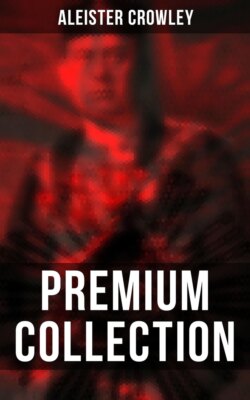Читать книгу ALEISTER CROWLEY - Premium Collection - Aleister Crowley - Страница 62
На сайте Литреса книга снята с продажи.
Chapter II.
The Circle
ОглавлениеTable of Contents
The Circle announces the Nature of the Great Work.
Though the Magician has been limited in his choice of room, he is more or less able to choose what part of the room he will work in. He will consider convenience and possibility. His circle should not be too small and cramp his movements; it should not be so large that he has long distances to traverse. Once the circle is made and consecrated, the Magician must not leave it, or even lean outside, lest he be destroyed by the hostile forces that are without.
He chooses a circle rather than any other lineal figure for many reasons; e.g.,
1. He affirms thereby his identity with the infinite.
2. He affirms the equal balance of his working; since all points on the circumference are equidistant from the centre.
3. He affirms the limitation implied by his devotion to the Great Work. He no longer wanders about aimlessly in the world.
The centre of this circle is the centre of the Tau of ten squares which is in the midst, as shown in the illustration. The Tau and the circle together make one form of the Rosy Cross, the uniting of subject and object which is the Great Work, and which is symbolized sometimes as this cross and circle, sometimes as the Lingam-Yoni, sometimes as the Ankh or Crux Ansata, sometimes by the Spire and Nave of a church or temple, and sometimes as a marriage feast, mystic marriage, spiritual marriage, "chymical nuptials," and in a hundred other ways. Whatever the form chosen, it is the symbol of the Great Work.
This place of his working therefore declares the nature and object of the Work. Those persons who have supposed that the use of these symbols implied worship of the generative organs, merely attributed to the sages of every time and country minds of a calibre equal to their own.
The Tau is composed of ten squares for the ten Sephiroth.25 About this Tau is escribed a triangle, which is inscribed in the great Circle; but of the triangle nothing is actually marked but the three corners, the areas defined by the cutting of the lines bounding this triangle. This triangle is only visible in the parts which are common to two of the sides; they have therefore the shape of the diamond, one form of the Yoni. The significance of this is too complex for our simple treatise; it may be studied in Crowley's "Berashith."
The size of the whole figure is determined by the size of one square of the Tau. And the size of this square is that of the base of the Altar, which is placed upon Maukuth. It will follow then that, in spite of the apparent freedom of the Magician to do anything he likes, he is really determined absolutely; for as the Altar must have a base proportionate to its height, and as that height must be convenient for the Magician, the size of the whole will depend upon his own stature. It is easy to draw a moral lesson from these considerations. We will merely indicate this one, that the scope of any man's work depends upon his own original genius. Even the size of the weapons must be determined by necessary proportion. The exceptions to this rule are the Lamp, which hangs from the roof, above the centre of the Circle, above the square of Tiphereth; and the Oil, whose phial is so small that it will suit any altar.
On the Circle are inscribed the Names of God; the Circle is of green, and the names are in flaming vermilion, of the same colour as the Tau. Without the Circle are nine pentagrams equidistant,26 in the centre of each of which burns a small Lamp; these are the "Fortresses upon the Frontiers of the Abyss." See the eleventh Aethyr, Liber 418 ("Equinox V"). They keep off those forces of darkness which might otherwise break in.
The names of God form a further protection. The Magician may consider what names he will use; but each name should in some way symbolise this Work in its method and accomplishment. It is impossible here to enter into this subject fully; the discovery or construction of suitable names might occupy the most learned Qabalist for many years.
These nine lamps were originally candles made of human fat, the fat of enemies27 slain by the Magician; they thus served as warnings to any hostile force of what might be expected if it caused trouble. To-day such candles are difficult to procure; and it is perhaps simpler to use beeswax. The honey has been taken by the Magician; nothing is left of the toil of all those hosts of bees but the mere shell, the fuel of light. This beeswax is also used in the construction of the Pantacle, and this forms a link between the two symbols. The Pantacle is the food of the Magus; and some of it he gives up in order to give light to that which is without. For these lights are only apparently hostile to intrusion; they serve to illuminate the Circle and the Names of God, and so to bring the first and outmost symbols of initiation within the view of the profane.
These candles stand upon pentagrams, which symbolize Geburah, severity, and give protection; but also represent the microcosm, the four elements crowned by Spirit, the Will of man perfected in its aspiration to the Higher. They are placed outside the Circle to attract the hostile forces, to give them the first inkling of the Great Work, which they too must some day perform.
